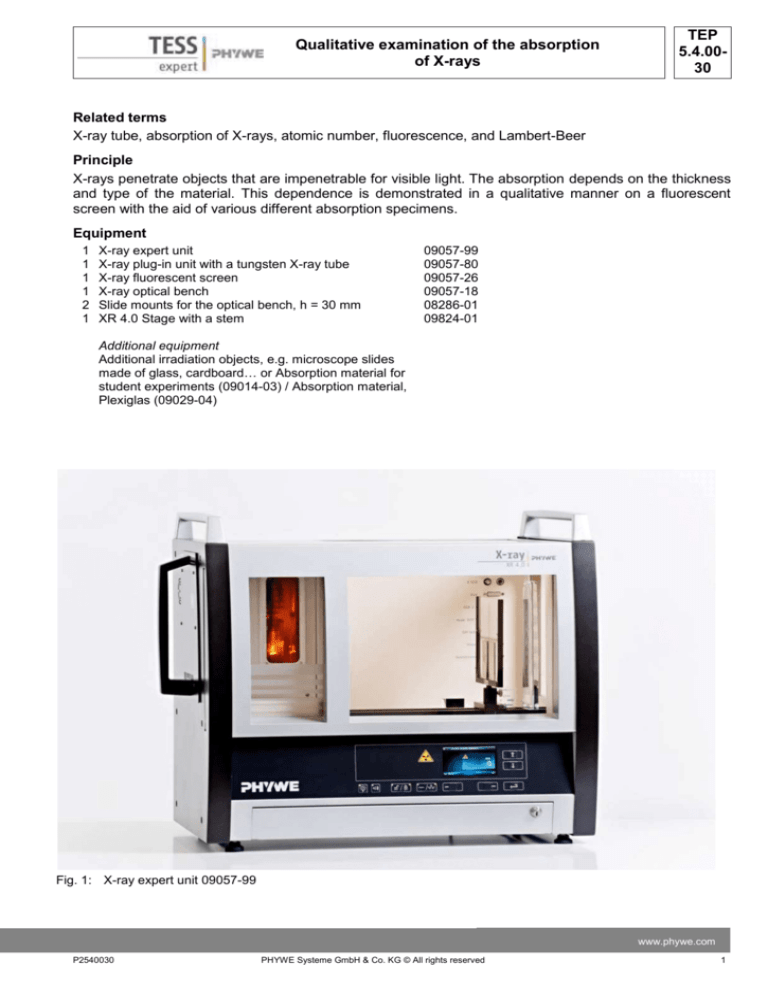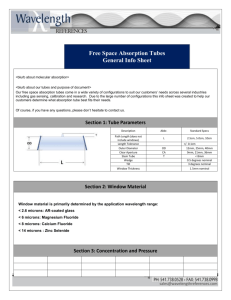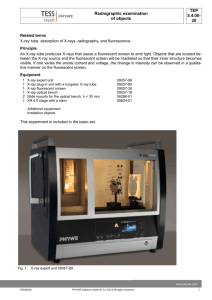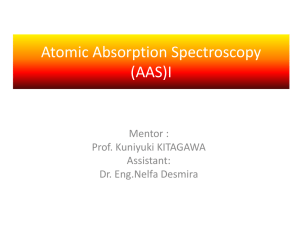
Qualitative examination of the absorption
of X-rays
TEP
5.4.0030
Related terms
X-ray tube, absorption of X-rays, atomic number, fluorescence, and Lambert-Beer
Principle
X-rays penetrate objects that are impenetrable for visible light. The absorption depends on the thickness
and type of the material. This dependence is demonstrated in a qualitative manner on a fluorescent
screen with the aid of various different absorption specimens.
Equipment
1
1
1
1
2
1
X-ray expert unit
X-ray plug-in unit with a tungsten X-ray tube
X-ray fluorescent screen
X-ray optical bench
Slide mounts for the optical bench, h = 30 mm
XR 4.0 Stage with a stem
09057-99
09057-80
09057-26
09057-18
08286-01
09824-01
Additional equipment
Additional irradiation objects, e.g. microscope slides
made of glass, cardboard… or Absorption material for
student experiments (09014-03) / Absorption material,
Plexiglas (09029-04)
Fig. 1: X-ray expert unit 09057-99
www.phywe.com
P2540030
PHYWE Systeme GmbH & Co. KG © All rights reserved
1
TEP
5.4.0030
Qualitative examination of the absorption
of X-rays
Tasks
1. Observe the transmission of X-rays as a function of the material thickness.
2. Determine how the atomic number of the elements in a material affects the transmission of X-rays.
Set-up and procedure
If a goniometer is installed in the experiment chamber, it should be removed if possible.
Install the optical bench and position the fluorescent screen in its holder on the optical bench as far
to the right as possible. In order to position the various objects in front of the fluorescent screen in a
stable manner, we recommend using the object tables. Darken the room.
-
You will obtain a high-contrast image with maximum anode voltage (35 kV) and maximum anode
current (1.0 mA).
-
For task 1, position the aluminium specimens of different thicknesses next to each other in front of
the screen. Close and lock the door. Then, activate the X-radiation. Observe the result on the fluorescent screen. You can also place the specimens on top of each other. Repeat this with the Plexiglas plates.
For task 2, the comparison of different materials, such as acrylic glass and mineral glas very interesting. Interchange the materials repeatedly and observe the result.
-
Taking a picture with a digital camera:
Fasten the camera to a slide mount on the optical bench.
Switch it to night mode and deactivate the flash.
Either darken the room completely or cover the unit with its cover.
We recommend starting the camera with the self-timer so that the picture does not blur during the
handling of the camera.
Theory
X-rays penetrate objects that are impenetrable for visible light. Visible light is absorbed for a far lower extent. The absorption depends on the thickness and type of the material. While in the past X-rays were
even used to check whether a shoe fits well, we now know about the harmful effects of the radiation. At
airports, it is used in order to inspect luggage.
When X-rays with the intensity I0 hit matter of the thickness d, the intensity I of the transmitted radiation
is as follows in accordance with the law of absorption (see experiment P2541101):
I I 0e , Z d
(1)
I: intensity of the radiation behind the absorber
I0: initial intensity of the radiation
μ: linear absorption coefficient
d: thickness of the material
2
PHYWE Systeme GmbH & Co. KG © All rights reserved
P2540030
Qualitative examination of the absorption
of X-rays
TEP
5.4.0030
The transmission is defined as the quotient of I (intensity of the radiation behind the absorber) and I0 (initial intensity of the radiation).
Equation (1) directly shows that the intensity of the radiation behind the absorber also depends on the
thickness of the absorber.
The so-called linear absorption coefficient μ [cm-1] depends on the wavelength λ of the radiation as well
as on the atomic number Z of the absorbing matter. Since the absorption of the absorbing matter is proportional, often the so-called mass absorption coefficient μ/ρ [cm2/g] is used, with ρ as the density of the
absorber.
The following processes are responsible for the attenuation:
- photoelectric effect
- scattering
- pair production
Here, however, absorption due to pair production
can be excluded, since the X-rays do not have the
required energy level.
As a result, the absorption coefficient for X-rays consists of two parts:
τ = absorption coefficient of the photoelectric effect
σ = scattering coefficient
In the wavelength range that is used for this experiment, the photoelectric effect dominates (τ > σ).
The absorption for this case can be described with
the following empirical relationship:
Fig. 2: Plexiglas, from left to right: d = 1 mm, 5 mm, and
10 mm (top: no absorber)
k 3 Z 3
(2)
In accordance with (2), the absorption capacity drastically increases when the wavelength λ increases as
well as when the atomic number Z of the absorber
increases.
Evaluation and results
Task 1: Observation of the transmission of X-rays as
a function of the material thickness
As Figures 2 and 3 show, the absorption strongly
depends on the material thickness, as it also follows
Fig. 3: Aluminium, from left to right: d = 0.3 mm, 0.5 mm,
from equation 1.
and 1 mm
www.phywe.com
P2540030
PHYWE Systeme GmbH & Co. KG © All rights reserved
3
TEP
5.4.0030
Qualitative examination of the absorption
of X-rays
Task 2: Observation of the transmission of X-rays as a function of the atomic number
Acrylic glass vs. mineral glass (Fig. 4):
Since Plexiglas is an organic polymer, it mainly consists of carbon (Z = 6), hydrogen (Z = 1), and oxygen
(Z = 8), i.e. of elements with a low atomic number. Mineral glass contains silicon ( Z = 14) that can be
found directly under carbon in the periodic table of elements. It has a higher atomic number, which results in a considerably higher absorption of X-rays in mineral glass.
Cardboard/aluminium vs. iron (Fig. 5)
In this case, the difference between the atomic numbers of the two elements (Al: Z = 13; Fe: Z = 26) also
has a strong effect. Cardboard consists mainly of organic materials. Compared to metals, the elements
that are mainly involved, i.e. carbon (Z = 6), hydrogen (Z = 1), and oxygen (Z = 8), have very low atomic
numbers.
Fig. 4: Plexiglas (left, d = 1 mm) and glass (right, d = 1
mm)
4
Fig. 5: From left to right: aluminium, cardboard, iron
(all of them: d = 1mm)
PHYWE Systeme GmbH & Co. KG © All rights reserved
P2540030









